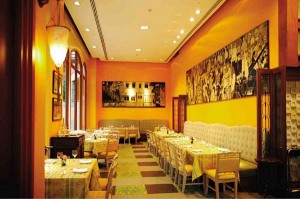10 lessons from a restaurateur of 25 years
Putting up and actually running a restaurant are far from easy and not as glamorous as most people think.
According to Ramon Ricardo V. Gutierrez, president and CEO of the 1771 Group of Restaurants that operates the Chateau 1771, Sentro and Café 1771 restaurant concepts, it is not enough to know how to cook good food.
Having culinary masterpieces accounts for just 30 percent of what are required to make it big in the crowded food scene. The balance involves actually managing the restaurant, reining in costs, marketing and more importantly, winning and retaining the loyalty of finicky customers.
Gutierrez knows whereof he speaks as the 1771 Group of Restaurants, particularly the flagship Chateau 1771 brand, has been in the industry for 25 years. It has managed to remain ahead of the pack despite changes in location as well as stiff competition from both old and new rivals.
Gutierrez shares with the Inquirer some key lessons learned over the past 25 years that other entrepreneurs who want to break into the restaurant scene would do well to take note of.
1. Manage your costs.
The food sector is a crazy business. The food will bring in the people at the start, but if you don’t know how to manage costs, then the restaurant will ultimately fail. Knowing your costs means knowing how to get the best available goods without compromising quality. The problem with some restaurateurs is that when the costs start hitting them hard, they tweak the food and that affects the quality. The customers will know that.
2. Constantly reinvent yourself.
The first few years of a restaurant can be very good, but you will inevitably hit a plateau and the costs will start catching up with you. Before that happens, you have to reinvent yourself. When we saw the market shift away from Malate, we moved in 1994 to Ortigas, which was booming then. And then when people moved to Makati, we moved there, too.
3. Invest in market research.
Know what your competition is doing. You should always be on your toes because there is always something new coming up. You have to know what is happening in the market and their preferences so that your restaurant can provide that. In Ortigas, for example, we saw a spurt in the growth of a young market so Café 1771, WB 1771 and Sidebar are there to cater to that growing market.
4. Be obsessive about details.
The type of guests that we cater to likes food, enjoys food and appreciates a good experience, so that means taking care of little details that make a big impact such as a clean and sweet smelling bathroom and table settings. My market appreciates these things and is willing to pay for them.
5. Don’t compromise on quality.
When we design our menu, we look at the best items that our customers can afford. And once that is set, there should be no going back. You do not want to compromise on the quality of the food because that is a sure way to lose customers. At 1771, we use the best possible fresh ingredients while keeping an eye on costs.
6. Know your target market.
Running a restaurant is also about positioning, you can’t be all things to all people. If you are targeting the middle market, then you can go for comfort Filipino food, not foie gras. The market will determine the food you will serve, the presentation, portioning of the food and also the location of the restaurant. The market will also determine the prices at which you will sell the food.
7. Ensure customer satisfaction.
Customers, even the loyal ones, will not be happy with you all the time. Perhaps the chef had a bad day or there was a bad shipment. What is important is that you should be able to do something about it. Never be afraid to take out an item from the bill if the customer is truly unsatisfied with it. What is important is to retain relationships with customers. As a restaurateur, it is important for me that the people like my food and my service.
8. Develop close relationships with suppliers, workers
Running a restaurant involves a web of relationships with suppliers, cooks, waiters, and customers. It pays to nurture those relationships for the long term. With suppliers, you have to pay them right and on time. For the employees, never embarrass them in front of guests and reward them for good work. Do not interfere with their tips and service charge because that is theirs. Take care of your staff and they will take care of the customers and ultimately, you. Above all, be fair. Give them what is right and what is due them at the right time.
9. Gather valuable feedback.
Once in a while, check back with your customers and ask them about the food and the service. Follow up with a text or e-mail just to find out how the restaurant is doing from their perspective. It is also nice if you can ask friends to tell you the truth even if it hurts. That way, you will be able to do something about it and continue delivering the standards that you have promised to deliver.
10. Personally monitor the restaurant
There is no substitute for personal involvement in the restaurant. That is one reason why we have stayed within Metro Manila because we have agreed to personally supervise the restaurants. I conduct all of my meetings in the restaurants so that I can see how the restaurant is being run. It also keeps me close to the staff and the customers. Being there also gives my partners and I the opportunity to see the industry and to remain on top of the situation. Running a restaurant is a process of consistent reinvention, of keeping your brand fresh and competitive. Never become arrogant or neglectful. The moment that happens is the start of your downfall.




